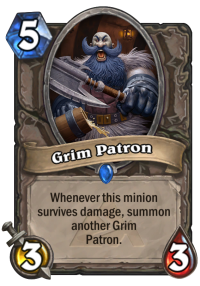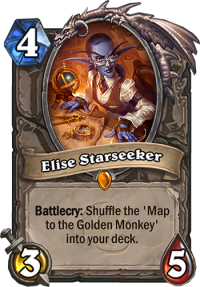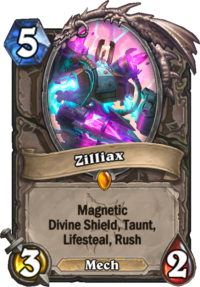One of the more interesting and underappreciated aspects of the new Overkill mechanic is how it’s leaning on an already existing element of gameplay in Hearthstone in order to change the available strategies instead of creating something from scratch like Discover or Echo. In fact, this is the more common approach looking back at the history of the game: many of the tools and keywords were cleverly re-purposed or expanded upon over time, creating an unbroken thread of sorts between the gameplay of old and new.
All Around Me are Familiar Faces
In a way, most of the recently introduced keywords in Hearthstone harken back to some sort of a previously introduced mechanic. Overkill was a naturally beneficial result of value-trading, Rush was a diluted version of Charge (and soft-launched by cards like Charged Devilsaur and Icehowl). We’ve discussed this particular (d)evolution pretty extensively in recent articles.

Further back in time, Recruit was merely a variation on the effect previously seen on Y'Shaarj, Rage Unbound and Finja, the Flying Star – or cards like Mysterious Challenger if you consider pulling spells analogous to minions. The list could go on. Similarly, Rebuke is a remix of the Loatheb theme, everyone’s favorite jam in the latter half of 2014 – and an interesting admission that the legendary minion was overstatted by four or five points, which seems about right in retrospect. Even with class cards having a higher power level than their neutral counterparts, it’s a pretty massive climb-down in comparison.
You could also look at Ice Block – a card whose power level prompted its move to the Hall of Fame – is also making a comeback of sorts across different cards, either via Evasion in Rogue or the recently announced Time Out! in Paladin. The upgraded hero powers granted by Justicar Trueheart have also returned, perhaps playing a larger part in the game than ever before. Sometimes, these reincarnations are as explicit as they can get – Elise #1 and #2 would like to have a word with you about that in particular.

This is a good way to keep the game accessible: Team 5’s continued focus on the new player demographic may have devolved into meme-ry by now in the eyes of the hardcore community, but it’s certainly true that expanding on Hearthstone’s themes this way keeps the learning curve more reasonable to those that would opt to enter Azeroth’s taverns for the first time in the present. Thematically, it also ensures that the mechanics that have rotated into Wild – a mode that, lest we forget, doesn’t resonate with most of the playerbase – get to experience at least a variation on the themes that were previously in the game.
Sometimes this manifests in a conscious push to make a specific mechanic playable. Think of how Princess Huhuran was below the power curve and never saw play, only to be superseded by Terrorscale Stalker later on – a move that does not constitute power creep since the original card saw no play to begin with. Dark Cultist was also “upgraded” into Kabal Talonpriest, just like Bear Trap “became” Wandering Monster. (Of course, you can find examples of the effect going in the opposite direction: while Imp-losion has never received the nerf it likely deserved, the existence of Feeding Time pretty much works as a tacit admission by the developers that they probably missed the boat on that one.)
More of the Same?
The flipside of this approach is the potential rise of the sort of same-y gameplay experience that many complained about over the course of the last two sets: gradual shifts instead of a real earthquake with nothing in sight that could push the existing archetypes out of the spotlight. This is not a necessary consequence of this approach though: just consider the impact of Recruit at the end of last year.
It’s also worth keeping in mind that most of the egregious, nerf-warranted and/or seriously disliked mechanics of Hearthstone have all overstretched the boundaries of the game in some ways, there are some serious benefits to this sort of a conservative strategy – and as I’ve previously argued, even expansions like The Boomsday Project will be better appreciated later down the line. Team 5 has historically been great at keeping up the hype related to their title – it seems like they’re also doing a better job at balancing as well nowadays.

All in all, being able to explore new facets of gameplay while basically relying on already existing tools is an incredibly valuable feather in the developers’ cap as releasing brand new keywords with original implications every set would quickly make Hearthstone extremely bloated. That’s not to say innovation is unwelcome – but being able to create more from less is a pretty important element of Hearthstone’s enduring success. (The jokes about the Unity engine pretty much write themselves as this point.) Or as Stephen Chang, one of the designers recently stated,
“It’s very difficult to find very simple keywords that have high gameplay impact. To find a nice, clean, simple combat keyword like Overkill where it changes the decisions you make on your board trades is very cool.”
Whatever you may think about Hearthstone’s overall design direction, you can’t argue that this is something they are very, very good at.
